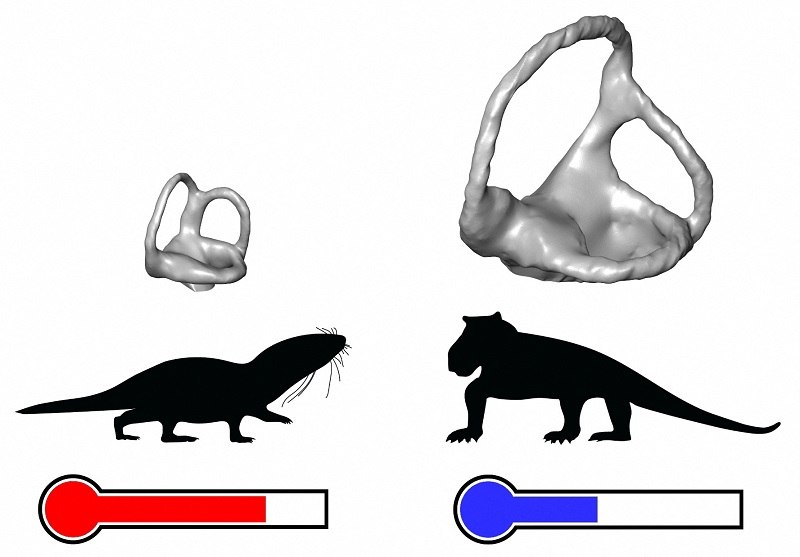
Size differences between inner ears (in grey) of warm-blooded mammaliamorphs, left, and cold-blooded, earlier synapsids, right.
12:15 JST, August 4, 2022
WASHINGTON (Reuters) — Scientists have answered a longstanding question about mammalian evolution, examining the ear anatomy of living and extinct mammals and their close relatives to determine when warm-bloodedness — a trait integral to the lineage’s success — first emerged.
Researchers said July 20 that the reduced size of inner ear structures called semicircular canals — small, fluid-filled tubes that help in keeping balance — in fossils of mammal forerunners showed that warm-bloodedness, called endothermy, arose roughly 233 million years ago during the Triassic period.
These first creatures that attained this milestone, called mammaliamorph synapsids, are not formally classified as mammals, as the first true mammals appeared roughly 30 million years later. But they had begun to acquire traits associated with mammals.
Endothermy evolved at a time when important features of the mammal body plan were falling into place, including whiskers and fur, changes to the backbone related to gait, the presence of a diaphragm, and a more mammal-like jaw joint and hearing system.
“Endothermy is a defining feature of mammals, including us humans. Having a quasi-constant high body temperature regulates all our actions and behaviors, from food intake to cognition, from locomotion to the places where we live,” said paleontologist Ricardo Araujo of the University of Lisbon’s Institute of Plasmas and Nuclear Fusion, colead author of the study published in the journal Nature.
The high metabolisms of mammal bodies maintain internal temperature independent of their surroundings. Cold-blooded animals like lizards adopt strategies like basking in the sun to warm up.
Mammalian endothermy arrived at an eventful evolutionary moment, with dinosaurs and flying reptiles called pterosaurs — creatures that long would dominate ecosystems — first appearing at about that time. Endothermy offered advantages.
“Run faster, run longer, be more active, be active through longer periods of the circadian cycle, be active through longer periods of the year, increase foraging area. The possibilities are endless. All this at a great cost, though. More energy requires more food, more foraging, and so on. It is a fine balance between the energy you spend and the energy you intake,” Araujo said.
The mammalian lineage evolved from cold-blooded creatures, some boasting exotic body plans like the sail-backed Dimetrodon, mixing reptile-like traits like splayed legs and mammal-like traits like the arrangement of certain jaw muscles.
Endothermy emerged relatively quickly, in perhaps less than a million years, rather than a longer, gradual process, said paleontologist and study colead author Romain David of the Natural History Museum in London.
An early example was a vaguely weasel-like species, Pseudotherium argentinus, in Argentina about 231 million years ago. The later true mammals were the ancestors of today’s three mammalian groups: placentals, marsupials and monotremes.
“Given how central endothermy is to so many aspects of the body plan, physiology and lifestyle of modern mammals, when it evolved in our ancient ancestors has been a really important unsolved question in paleontology,” said paleontologist and study coauthor Ken Angielczyk of the Field Museum in Chicago.
Determining when endothermy originated through fossils has been tough. As Araujo noted: “We cannot stick thermometers in the armpit of your pet Dimetrodon, right?”
The inner ear provided a solution. The viscosity, or runniness, of inner ear fluid — and all fluid — changes with temperature. This fluid in cold-blooded animals is cooler and thicker, necessitating wider canals. Warm-blooded animals have less viscous ear fluid and smaller semicircular canals.
The researchers compared semicircular canals in 341 animals, 243 extant and 64 extinct. This showed endothermy arriving millions of years later than some prior estimates.
Mammals played secondary roles in ecosystems dominated by dinosaurs before taking over after the mass extinction event 66 million years ago. Among today’s animals, mammals and birds are warm-blooded.
“It is maybe too far-fetched, but interesting, to think that the onset of endothermy in our ancestors may have ultimately led to the construction of the Giza pyramids or the development of the smartphone,” Araujo said. “If our ancestors would have not become independent of environmental temperatures, these human achievements would probably not be possible.”
"Science & Nature" POPULAR ARTICLE
-

Genome Study Reveals Milestone in History of Cat Domestication
-

Big Leap in Quest to Get to Bottom of Climate Ice Mystery
-

Security Camera Footage Vulnerable to Outside Access; Investigation Finds 3,000 Pieces Exposed Online
-

Japan Set to Participate in EU’s R&D Framework, Aims to Boost Cooperation in Tech, Energy
-

Paws on Parade: Nairobi’s Dogs Dazzle at ‘Pawchella’
JN ACCESS RANKING
-

Tokyo Economic Security Forum to Hold Inaugural Meeting Amid Tense Global Environment
-

Keidanren Chairman Yoshinobu Tsutsui Visits Kashiwazaki-Kariwa Nuclear Power Plant; Inspects New Emergency Safety System
-

Imports of Rare Earths from China Facing Delays, May Be Caused by Deterioration of Japan-China Relations
-

University of Tokyo Professor Discusses Japanese Economic Security in Interview Ahead of Forum
-

Japan Pulls out of Vietnam Nuclear Project, Complicating Hanoi’s Power Plans






















